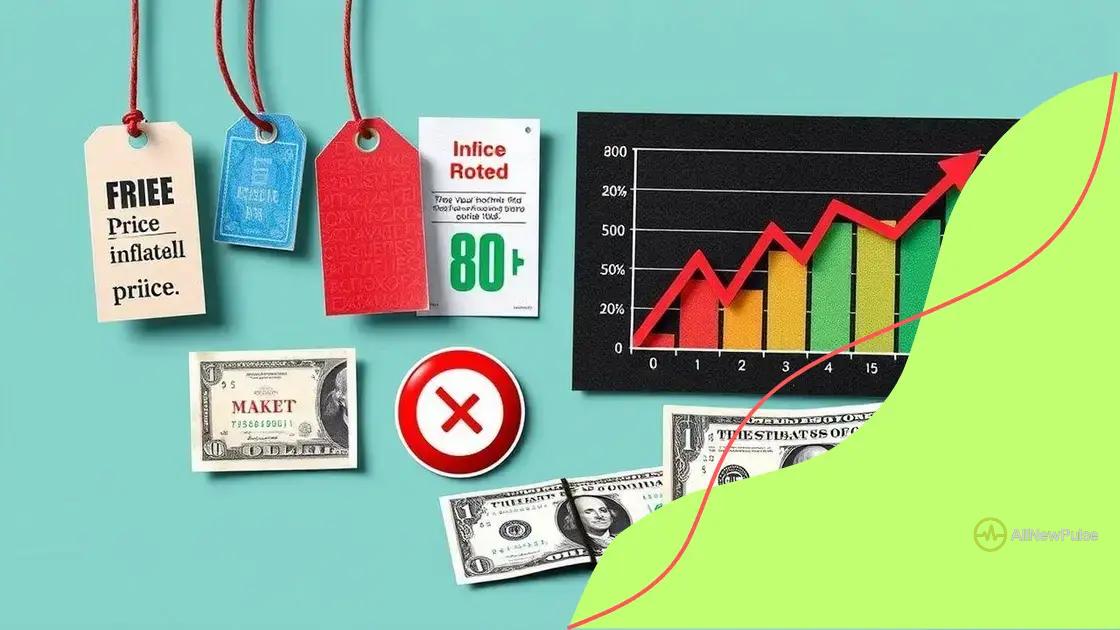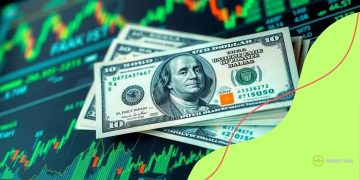Assessing the strength of the US dollar in today’s economy

Assessing the strength of the US dollar involves analyzing factors like economic growth, inflation, interest rates, and global conditions that influence currency values and investment decisions.
Assessing the strength of the US dollar can feel overwhelming, right? With global markets constantly shifting, it’s crucial to grasp how this affects your wallet and investing strategies. Let’s dive into what influences its value.
Factors influencing the US dollar’s value
Understanding the factors influencing the US dollar’s value is essential for grasping how economies interact globally. The dollar is often viewed as a benchmark for global currencies, so its strength can impact various markets.
Economic Indicators
One of the main elements affecting the dollar’s value is economic indicators. Reports on job growth, gross domestic product (GDP), and consumer spending provide insights into the economy’s health. When these indicators show growth, the dollar tends to strengthen.
Interest Rates
Interest rates set by the Federal Reserve also play a crucial role. Higher interest rates typically attract foreign investment, increasing demand for the dollar. When rates rise, investors seek better returns, boosting the dollar’s value.
- Inflation levels affect purchasing power
- Political stability influences foreign investments
- Trade balances can either strengthen or weaken the dollar
Additionally, geopolitical factors can cause fluctuations. For example, tensions or stability in foreign regions can impact investor confidence and the dollar’s appeal. A stable political environment often leads to a strengthened dollar as it fosters reliable investment opportunities.
Market sentiment also plays a significant role. Traders’ perceptions about future economic conditions can lead to swift changes in currency value. Keeping an eye on public confidence can provide essential clues regarding the dollar’s trajectory.
In summary, various interconnected factors shape the value of the US dollar. By monitoring economic indicators, interest rates, and geopolitical circumstances, one gains valuable insights into currency movements.
Comparative analysis with other currencies
A comparative analysis with other currencies can provide valuable insights into the strength of the US dollar. By understanding how the dollar stacks up against major currencies, we can better appreciate its global standing.
Major Currency Comparisons
When we examine currencies like the Euro, Japanese Yen, and British Pound, we see that fluctuations often reflect economic conditions. For instance, if the US economy is thriving, the dollar generally performs well against these currencies.
Exchange Rate Implications
The exchange rate is a critical factor to watch. Changes in exchange rates influence international trade and investment flows. When the dollar appreciates in value, imports become cheaper, benefiting consumers, while exports may struggle due to higher prices for foreign buyers.
- Strengthened dollar increases purchasing power abroad
- Weaker dollar can boost export competitiveness
- Market volatility can affect currency values
Additionally, central banks around the world play a crucial role in currency valuation. Their policies regarding interest rates and inflation targeting can significantly impact how the dollar is perceived globally. A dovish stance may weaken the dollar, while a hawkish approach can strengthen it.
In the context of global trade, a strong US dollar can impact economies differently. Countries that rely heavily on exports may feel a pinch when the dollar rises. Conversely, nations that import goods will benefit from lower prices. Understanding these dynamics helps illuminate the broader effects of currency valuation on global markets.
As investors analyze these factors, they gain a clearer picture of how the dollar’s strength affects their portfolios. Whether through currency trading or international investments, knowledge of comparative currency analysis is essential.
The impact of inflation on the dollar

The impact of inflation on the dollar is a crucial topic within the economy. Inflation refers to the rate at which the general level of prices for goods and services rises, leading to a decrease in purchasing power. As inflation increases, consumers find that their dollars do not stretch as far as they used to.
Inflation and Purchasing Power
When inflation rises, the value of the US dollar can decrease. This is because the same amount of money buys fewer goods and services. Consequently, consumers may feel squeezed, which can affect their spending habits.
Central Bank Responses
The Federal Reserve reacts to inflation in various ways. When inflation is high, the Fed might increase interest rates to cool off the economy. Higher interest rates can strengthen the dollar by attracting foreign investment, as investors seek better returns from US assets.
- Higher interest rates may deter borrowing
- Lower consumer spending can decrease economic growth
- Exchange rates may fluctuate based on inflation forecasts
However, if inflation remains unchecked for too long, it can lead to a loss of confidence in the dollar. This can cause investors to seek alternatives, such as gold or other currencies, leading to further depreciation of the dollar.
A balance is vital. While moderate inflation can be beneficial for economic growth, excessive inflation poses threats. Investors often watch inflation reports closely, as these impact decisions in stock markets and currency trading.
In conclusion, understanding the relationship between inflation and the dollar helps consumers and investors navigate the economic landscape effectively. Keeping an eye on inflation trends can provide insights into future currency movements.
How monetary policy shapes the dollar’s strength
Understanding how monetary policy shapes the dollar’s strength is essential for grasping economic dynamics. Central banks, particularly the Federal Reserve in the United States, use monetary policy as a tool to control inflation and stabilize the economy. By adjusting interest rates and managing the money supply, they influence the value of the dollar.
Interest Rate Adjustments
When the Federal Reserve raises interest rates, it typically strengthens the dollar. Higher interest rates attract foreign investments, as investors seek better returns. Conversely, when rates are lowered, the dollar can weaken because lower returns may deter investment.
Managing Inflation
Another significant aspect of monetary policy is controlling inflation. The Fed aims for a target inflation rate, usually around 2%. When inflation exceeds this target, the central bank may intervene. This can involve tightening monetary policy to cool down the economy, which often results in a stronger dollar.
- Stronger economy leads to a stronger dollar
- Weak economic indicators can prompt lower interest rates
- Expectations about future policy can influence currency strength
Furthermore, market perception plays a crucial role in how monetary policy affects the dollar. If investors believe the Fed will maintain a tight policy to combat inflation, the dollar could gain strength based on speculation alone. This shows the power of perception in financial markets.
In addition to domestic policy, international factors also impact the dollar’s strength. Global economic events and foreign central bank actions can create ripple effects in currency markets. Keeping an eye on these developments is vital for understanding the dollar’s standing in global trade.
Overall, the relationship between monetary policy and the strength of the dollar is complex yet critical. By analyzing interest rates and the broader economic context, investors can better navigate currency fluctuations.
Predictions for the future of the US dollar
Predictions for the future of the US dollar are influenced by various factors, including economic indicators, global market trends, and monetary policy decisions. Analysts closely examine these elements to forecast how the dollar may perform in the coming years.
Economic Growth Projections
One key predictor is the overall economic growth of the United States. If the economy continues to grow at a healthy rate, the dollar will likely strengthen. Economic expansion generally means increased consumer spending and higher investment, which can boost the dollar’s value.
Global Economic Conditions
Another crucial aspect is the global economic environment. Events such as trade agreements, geopolitical tensions, and economic downturns in other countries can affect the dollar’s position. For instance, if other major economies struggle, the dollar may gain as investors turn to it as a safe-haven currency.
- Potential effects of rising interest rates
- Impact of inflation on currency strength
- Changes in foreign investment patterns
The Federal Reserve’s monetary policy decisions will also play a critical role in shaping the future of the dollar. Should the Fed choose to increase interest rates to combat inflation, it could attract foreign capital, leading to a stronger dollar.
However, if the economy shows signs of weakening or inflation remains persistent, the dollar could face pressure. Predictions about the strength of the dollar are often based on a balance of these opposing factors. Investors must remain attentive to how these elements interact and affect the future.
As we look ahead, forecasting the dollar’s future involves understanding both domestic policies and global economic shifts. By monitoring key indicators, stakeholders can make informed decisions regarding investments and currency trading.
FAQ – Frequently Asked Questions about the US Dollar’s Strength
What factors influence the strength of the US dollar?
Several factors, including economic growth, inflation rates, interest rates, and global market conditions, influence the strength of the US dollar.
How does monetary policy affect the dollar?
Monetary policy, such as changes in interest rates by the Federal Reserve, can strengthen or weaken the dollar by influencing investment flows.
What is the impact of inflation on the dollar?
Inflation decreases the dollar’s purchasing power, meaning consumers can buy less with the same amount of money, which can lead to a weaker dollar.
Why is understanding the future of the dollar important for investors?
Understanding future predictions about the dollar helps investors make informed decisions regarding currency trading and investment strategies.





